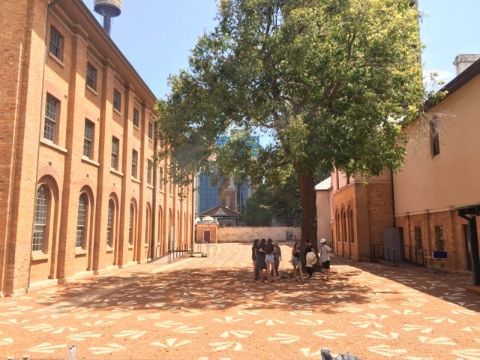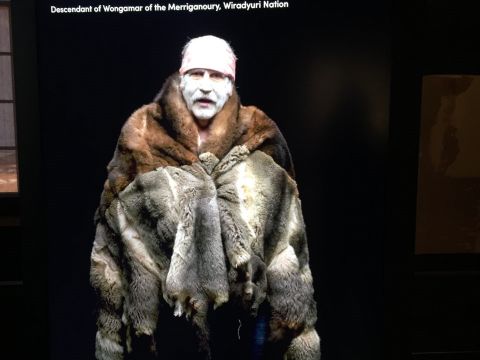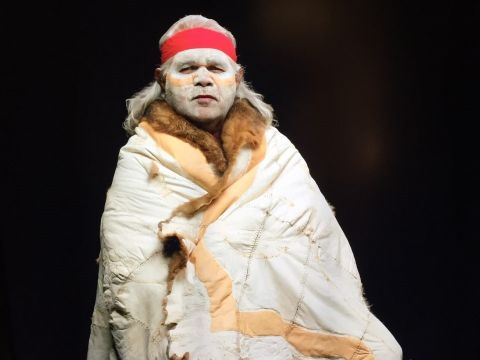Three Wiradyuri Elders from the Charles Sturt Wiradyuri Cultural Hub in Bathurst contributed content and feature in the new Hyde Parks Barracks colonial exhibition in Sydney.

The Elders from Gunhigal Mayiny Wiradyuri Dyilang Enterprise have been working with the Hyde Park Barracks project since late 2018, with Gadigal and Gamilaroi Elders involved in other displays.
The support for the Wiradyuri Elders was provided through the University’s Gulaay Indigenous Australian Curriculum and Resources team, which is the preferred agency of the Bathurst Wiradyuri Elders, whereby Gulaay helped facilitate the yarns, and organised an on-Country cultural immersion for the museum staff early in the project.
Part of the exhibition features life-size images of three Wiradyuri Elders – Dinawan (Uncle Bill Allen Jnr), Werribee (Aunty Leanna Carr-Smith), and Mallyan (Uncle Brian Grant) – clad in possum skin cloaks.
There are also two dioramas depicting the potato field massacre, and Millamarra, the killing hut story, both with audio played through headphones as visitors approach the exhibits.
 Mallyan (pictured left) said the Elders’ involvement in the project has been both very positive and confronting.
Mallyan (pictured left) said the Elders’ involvement in the project has been both very positive and confronting.
“Our involvement in Hyde Park Barracks was impromptu, actually,” he said.
“They (the exhibition curators) came to us and said, ‘Because of your links within the context of the colonial rule into Bathurst, what stories could you tell us?’
“That started a conversation that grew and grew and grew, to the point where they videotaped interviews with all of us to get our interpretation of where we sit in the world.
“They asked us to relate our feelings, both Wiradyuri and our colonial background.
“I’ve got colonial background as well as Wiradyuri in my DNA, so when we sat down and related the connection it was enormous, because my white ancestor was one of the first convicts into the colony.
“So once we related those stories it was a whole new story, and resulted in a massive amount of video footage.”
Mallyan explained that when the Elders arrived at Hyde Park Barracks for the exhibition opening − the first time they had seen it − they found it confronting.
The exhibition curators welcomed them, saying, ‘We’d like to show you who you are and what you’ve presented’.
“The confronting part was standing there in front of myself in full-life scale in my possum skin cloak with my makeup (ochre), and speaking in language and also speaking in English,” Mallyan said.
 “I think the daunting part is that this is going to be a permanent part of that display.
“I think the daunting part is that this is going to be a permanent part of that display.
“It’s very hard to be individualised, and that’s what they’ve done with us.
“I find that was hard to accept in the first stages, but then they showed us through the display where they’ve actually linked our stories here (in Bathurst) to Hyde Park.
“So I think I’d like to go back again in my own time and stand back on my own to get another feeling about the whole place.
“But the link was strong, the words were strong, and I think there’s more to that story.”
Facilitating the University’s support for the Elders was Senior Lecturer Dr Barbara Hill, the Indigenous Curriculum and Pedagogy Co-ordinator, and Lead, Gulaay Indigenous Australian Curriculum and Resources team in the Charles Sturt Division of Learning and Teaching.
“We are delighted that the University was able to support the initiative as an official sponsor with Sydney Living Museums and the Hyde Park Barracks exhibition specifically,” Dr Hill said.
“Gulaay brokered the University’s support for the Elders’ involvements in the development of the exhibition, kept senior staff abreast of developments, and ensured the Elders and Gulaay staff were able to attend the exhibition launch.
 “I thank Hyde Park Barracks content curator and Director Ms Beth Hise for her interest and support to engage the Wiradyuri Elders in this significant national project.”
“I thank Hyde Park Barracks content curator and Director Ms Beth Hise for her interest and support to engage the Wiradyuri Elders in this significant national project.”
Dr Hill explained that Gulaay is currently leading a Charles Sturt project with the Elders and Faculty staff about the Bathurst Wars and Proclamation of Martial Law in August 1824.
“It is hoped the resources, material, digital and other artefacts gathered as part of the Bathurst Wars project will go into Charles Sturt curriculum in disciplines such as law, humanities, psychology, and the social sciences,” Dr Hill said.
“At the Elders’ request, and as a precondition of them being initially offered, the resources gathered by Hyde Park Barracks and Sydney Living Museums staff will be made available to our Charles Sturt students so that, in effect, a story that begins in Sydney will follow the song lines from there to Bathurst, and will be used by our teaching staff in their curriculum.”
* Video interview with Mallyan recorded at Charles Sturt Orientation Week 2020 welcome to new students in Bathurst on Monday 24 February, resulting in some background noise.





Social
Explore the world of social